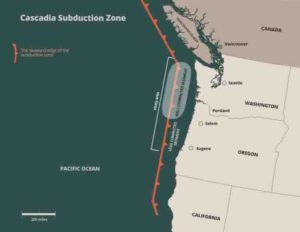
The Cascadia Subduction Zone off the coast of the Pacific Northwest has all the ingredients for making powerful earthquakes — and according to the geological record, the region is due for its next “big one.”
A new study led by The University of Texas at Austin has found that the occurrence of these big, destructive quakes and associated devastating tsunamis may be linked to compact sediments along large portions of the subduction zone. In particular, they found that big, destructive quakes may have a better chance of occurring offshore of Washington and northern Oregon than farther south along the subduction zone — although any large quake would impact the surrounding area.
“We observed very compact sediments offshore of Washington and northern Oregon that could support earthquake rupture over a long distance and close to the trench, which increases both earthquake and tsunami hazards,” said lead author Shuoshuo Han, a postdoctoral fellow at the University of Texas Institute for Geophysics (UTIG). UTIG is a research unit of the Jackson School of Geosciences.
The findings, published in Nature Geoscience on Nov. 20, are important for understanding factors that influence earthquake and tsunami generation in Cascadia and at other subduction zones around the world. Researchers from Columbia University and Penn State University also contributed to the study.
Subduction zones are areas where one tectonic plate dives or “subducts” beneath another plate. The world’s most powerful earthquakes are produced at the interface between the two plates. At certain subduction zones, such as those in Cascadia, Sumatra and eastern Alaska, a thick sediment layer overlies the subducting oceanic plate. Some of the sediment is scraped off during subduction and piled up on the top plate, forming a thick wedge of material, while the rest of the sediment travels down with the bottom plate.
How the stress is built up and released at the plate interface is greatly influenced by the degree of compaction of both the sediment wedge and the sediment between the plates. To understand sediment compaction along Cascadia, Han and her collaborators conducted a seismic survey off the coast of Washington and Oregon that allowed the researchers to see up to four miles of sediment layers overlaying the subduction zone. This was accomplished by the using nearly five-mile-long seismic streamers, a scientific tool used to image the seafloor using soundwaves.
“These kinds of long-streamer marine seismic studies provide the best tools available to the science community to efficiently probe subduction zones in high resolution,” said co-author Suzanne Carbotte, a research professor at Columbia University.
Combining the seismic data with measurements from sediment samples previously retrieved from this region through ocean drilling, they found that while the thickness of the incoming sediment is similar offshore of Washington and Oregon, the compaction is very different. Off the coast of Washington and northern Oregon, where almost all of the sediments glom on to the top plate and are incorporated into the wedge, the sediments were tightly packed together without much water in the pore space between the sediment grains — an arrangement that can make the plates more prone to sticking to each other and building up high stress that can be released as a large earthquake. In turn, the compacted sediments could boost the ability of large earthquakes to trigger large tsunamis because the sediments are able to stick and move together during earthquakes. This can boost their ability to move massive amounts of overlying seawater.
“That combination of both storing more stress and the ability for it to propagate farther is important for both generating large earthquakes and for propagating to very shallow depths,” said Nathan Bangs, a senior research scientist at UTIG and study co-author.
The propagation of earthquakes into shallow depths is what causes large tsunamis like the one that followed the Magnitude 9.0 earthquake that struck Tohoku, Japan in 2011.
In contrast, off the coast of central Oregon, the thick layer of subducting sediments are less compact, with water in the pore space between the grains. This arrangement prevents the plates from sticking as much, and allows them to rupture with less stress accumulated-thereby generating smaller earthquakes.
The Cascadia Subduction Zone generates a large earthquake roughly every 200 to 530 years. And with the last large earthquake occurring in 1700, scientists are expecting a large quake to occur in the future, although it’s impossible to pinpoint the timing exactly. The research findings can help scientists understand more about the features that make some areas of subduction zones better earthquake incubators than others.
“The results are consistent with existing constraints on earthquake behavior, offer an explanation for differences in structural style along the margin, and may provide clues about the propensity for shallow earthquake slip in different regions,” said co-author Demian Saffer, a Penn State University professor.
The study was funded by the National Science Foundation.
Reference:
Shuoshuo Han, Nathan L. Bangs, Suzanne M. Carbotte, Demian M. Saffer, James C. Gibson. Links between sediment consolidation and Cascadia megathrust slip behaviour. Nature Geoscience, 2017; DOI: 10.1038/s41561-017-0007-2
Note: The above post is reprinted from materials provided by University of Texas at Austin.










